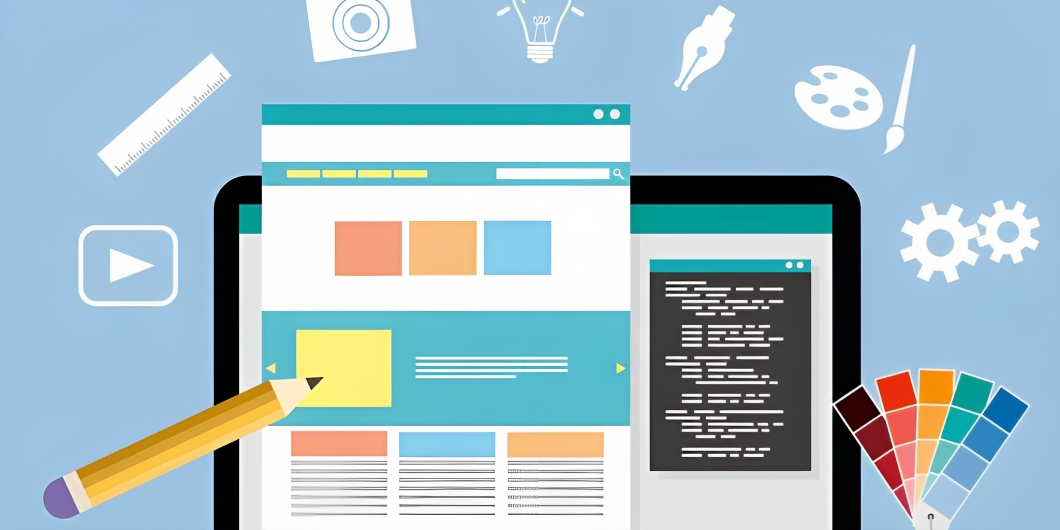- How to Create Engaging and User-Friendly Web and App Designs
- Steps to Creating a Highly Engaging Website
- Set a Project Plan
- Research the Latest Trends
- Create the Wireframes
- Define Homepage Navigation
- Design Other Website Elements
- Consider how users will use the app to begin
- Consider Visual Forms Of Navigation
- Create Personalized Features
- Include Mobile-Native Capabilities
- Make sure clients do not have to switch devices to use services
- Incorporate Bottom Navigation And Search Bars
- Make Sure To Test The Site Thoroughly
- Test on the platform that users will use
- Do not aggressively promote your mobile app on your mobile site
- Standardize Navigational Patterns On Desktop And Mobile
- Understand what is accessible outside of the mobile app
- Do not Hide Purchasing Information And Options
- Incorporate Progressive Forms
- Do not Overload The App With Content
- Always Build Mobile-First
- Ensure The Site Is Fully Accessible
- Conclusion
How to Create Engaging and User-Friendly Web and App Designs
The way a user interacts with an interface typically determines their user experience. The creation of an intuitive and user-friendly design that attracts visitors and encourages them to stay on the website is one of the main objectives of UX design development. The success of the website or mobile application can be significantly impacted by how the design aspects are included. Although design trends are constantly changing, the basics never change. Before a visitor leaves the website, it is critical to make sure the design grabs their interest quickly.
A professionally designed website serves as a representation of the brand and is frequently used to gauge the caliber of services a company provides. This makes it essential to create a business website that is user-friendly, appealing, and simple to use with the proper balance of UI (user interface) and UX (user experience).
A website’s digital design and user experience (UI and UX) greatly influence how visitors can browse it and take the required action. Providing a memorable user experience can be described as the harmony of the best visual components, visuals, content, site structure, and navigation. Unsurprisingly, a poorly designed and difficult to use website would not generate any sales and can even turn away potential clients. To have a strong online presence and expand your business, you must adopt the proper strategy when creating an impressive and excellent website.

Steps to Creating a Highly Engaging Website
Website designing can be a very complicated process, which is why we have simplified steps to help you understand how to build an engaging and appealing website for your needs.
Set a Project Plan
Planning is the foundation of any successful endeavor, and this is true for web design as well. Therefore, before you do anything else, think about why you want a website and how it will increase your company’s revenue. Similarly to this, you should be aware of your unique requirements and the elements of your website that will be necessary to meet them.
Research the Latest Trends
Knowing your opponent and researching and analyzing their tactics is always a good idea. Additionally, you should keep an eye on industry developments and determine which websites appeal to readers of your genre the most. This will significantly aid you in achieving your professional objectives.
Create the Wireframes
Your website’s wireframe will provide you with a thorough understanding of the output and its visual organization. You must build the website’s framework in this step and determine which elements best support your concepts. At this step, you should also develop the website theme and color palette as well as its content, logo, and headers.
Define Homepage Navigation
To give visitors to your website the best first impression possible, the homepage should be carefully and attentively developed. It should also have the proper components to facilitate simple, intuitive navigation and direct people to the appropriate inner pages without any difficulty. To make it more user-friendly, make sure the inner pages have clear titles as well.
Design Other Website Elements
Design the pieces to make the UI/UX more interactive and interesting, then decide what kinds of motions to add to the website. To ensure that your ideas are properly included in the design, you should always prototype and extensively test your designs. This enables you to make changes and progress until you are completely happy with the result.
Consider how users will use the app to begin
Genuinely comprehend the intended use of the program by the user. According to research, most users prefer not to use business apps (such as those for banking, insurance, utilities, or the government) unless they absolutely must. The fastest entry and exit from the app provide the customer with the most value. Make transactions as simple as possible by removing all unnecessary app extensions.
Consider Visual Forms Of Navigation
The usage of dropdown or hamburger menus, which might be challenging for users to access or comprehend, is one issue that may develop. These menus might be useful for saving space on a small mobile screen, but if they are poorly labeled or disorganized, users may find them annoying. Instead, businesses should think about implementing more logical and visible navigation methods.
Create Personalized Features
Because there are so many distractions, engaging end customers on mobile is difficult. But everything changes the moment you personalize a feature or service. Additionally, it is critical to carefully evaluate where to place such a feature because the in-player response is generally higher than the out of player response. Make it personal and observe where the eyes are focused the most.
Include Mobile-Native Capabilities
The goal of the consumer’s use of the mobile device is diminished when businesses duplicate a mobile site experience from a website. Businesses should concentrate on locating native features that enhance a mobile app or website user experience. Eliminate any friction to make it simple for the customer to finish the process of finding a product or completing a purchase. Design is another important element.
Make sure clients do not have to switch devices to use services
Customers increasingly select where they interact with brands amid a shift in the balance of power and a move towards self service, and businesses’ mobile websites frequently fall short of expectations for seamless service. Businesses must make sure that customers can engage in conversations on mobile sites while still being able to make purchases, obtain personalized experiences, and seek assistance.
Incorporate Bottom Navigation And Search Bars
Businesses frequently suffer from mobile navigation, which includes the use of several menu types that are ineffective UI components. Users may find it challenging to use the site on their devices as a result. Companies should think about implementing a search bar to assist consumers locate what they’re looking for more quickly or a bottom navigation bar, which is easier to use on a small screen, to improve mobile navigation.
Make Sure To Test The Site Thoroughly
Many businesses do a poor job of testing their software when creating mobile sites, which causes a lot of issues with the user experience, navigation, performance, reaction time, and more. A poor user experience will ultimately result from insufficient testing.
Test on the platform that users will use
Examine every smartphone usability option. Many ideas do not translate as well to a mobile environment. On a desktop, for instance, a 12-card image grid with a hover state is fantastic since you can see everything. However, it is simply impossible to convert that into a column of the same amount of cards without a hover state. Utilizing the tools that your users will use, test what you produce. Give your experiences some credibility.
Do not aggressively promote your mobile app on your mobile site
Poor usability results from mobile sites frequently receiving the lowest priority. I recently ran into a situation when browsing a website for recent Brad Pitt films. Whenever I clicked on his name or pressed on the home page or search results, a pop up window urging me to download a mobile app would appear. The business’s objective is to persuade you to do that, yet their tenacity makes me uninterested in returning.
Standardize Navigational Patterns On Desktop And Mobile
On mobile websites, navigation is frequently one of the largest omissions. Mobile devices are unable to use full screen browser navigation methods. To ensure that your consumers are successful when using your mobile site, it is essential to develop standardized, simple navigational patterns that are compatible with both desktop and mobile browser usage.
Understand what is accessible outside of the mobile app
Be clear about what cannot be done or configured on mobile. I frequently discover that a mobile app lacks functionality that prevents me from performing actions that are possible on a website. Inform users clearly and concisely of your options outside of the mobile app.
Do not Hide Purchasing Information And Options
They hide valuable information, forcing prospective customers to look for it. The best way to increase sales, attract more potential consumers, and foster trust is to provide transparent prices and availability coupled with consumer preferred purchasing options.
Incorporate Progressive Forms
Do not forget about the form submission procedure. Employing progressive forms, which enable users to complete the form in several steps and allow them to save their progress and return at a later time, is one approach for businesses to reduce abandonment rates, enhance the user experience, and increase conversion rates.
Do not Overload The App With Content
The message is killed by excessive content. Fireworks have no place in mobile apps. Make sure the information about your services is clear and readable. The user may become irritated if the information is presented in the wrong sequence on the little screen due to improper selection and architecture. Before releasing anything to the public, test it.
Always Build Mobile-First
Web design the mobile version of every one of our websites before we design the desktop version. To ensure that the website appears fantastic on all devices and at all heights and widths, we also make sure that everything is coded to scale by percentage.
Ensure The Site Is Fully Accessible
Companies should create mobile websites that are accessible to individuals with impairments, as recommended by the W3C. It makes sense for any business to optimize a mobile website so that visitors with visual impairments may access it. The fundamental tenet should be that everyone, regardless of ability, should be able to engage, observe, comprehend, and contribute to the web.
Conclusion
To maintain high engagement, a great online application design is necessary. This post covered tried and true techniques for developing appealing web application UI designs that entice consumers to utilize your program repeatedly. These techniques, which range from employing context aware navigation and prioritizing interesting content to using high contrast and subtle animations, can help you design an easy-to-use interface for your users. Keep in mind that creating a successful bespoke web app necessitates a combination of UX and UI components as well as the interaction between the design and content teams. Happy designing for your upcoming online application.







